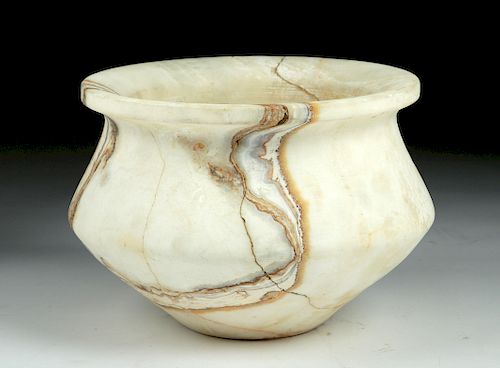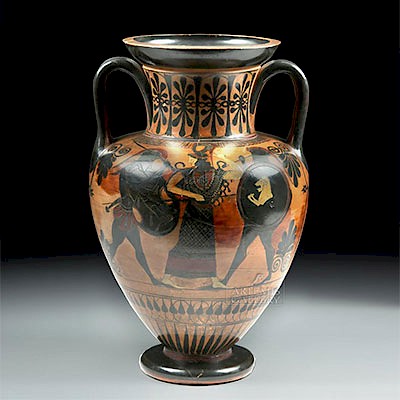Large Bactrian Banded Alabaster Vase
Lot 46a
About Seller
Artemis Fine Arts
686 S Taylor Ave, Ste 106
Louisville, CO 80027
United States
Selling antiquities, ancient and ethnographic art online since 1993, Artemis Gallery specializes in Classical Antiquities (Egyptian, Greek, Roman, Near Eastern), Asian, Pre-Columbian, African / Tribal / Oceanographic art. Our extensive inventory includes pottery, stone, metal, wood, glass and textil...Read more
Estimate:
$2,500 - $3,500
Absentee vs Live bid
Two ways to bid:
- Leave a max absentee bid and the platform will bid on your behalf up to your maximum bid during the live auction.
- Bid live during the auction and your bids will be submitted real-time to the auctioneer.
Bid Increments
| Price | Bid Increment |
|---|---|
| $0 | $25 |
| $300 | $50 |
| $1,000 | $100 |
| $2,000 | $250 |
| $5,000 | $500 |
| $10,000 | $1,000 |
| $20,000 | $2,500 |
| $50,000 | $5,000 |
| $100,000 | $10,000 |
| $200,000 | $20,000 |
About Auction
By Artemis Fine Arts
Oct 11, 2018
Set Reminder
2018-10-11 10:00:00
2018-10-11 10:00:00
America/New_York
Bidsquare
Bidsquare : Exceptional Antiquities | Ethnographic Art
https://www.bidsquare.com/auctions/artemis-gallery/exceptional-antiquities-ethnographic-art-3500
An important one-day auction featuring museum-worthy examples of classical antiquities, ancient and ethnographic art from cultures encompassing the globe. Artemis Fine Arts info@artemisfinearts.com
An important one-day auction featuring museum-worthy examples of classical antiquities, ancient and ethnographic art from cultures encompassing the globe. Artemis Fine Arts info@artemisfinearts.com
- Lot Description
Ancient Central Asia, Bactria (Bactria-Margiana/BMAC), ca. 3rd to 2nd millennium BCE. A gorgeous, hand-carved vase of creamy white alabaster presenting natural banding in coffee, caramel, grey, and russet hues. The vessel sits atop a narrow circular base, its bulbous body with a projecting midsection and a tapering shoulder, and a thick, flared rim leading towards a deep interior cavity. Alabaster, a light-colored calcareous stone quarried from the Iranian Plateau, had strong connections in the ancient world to religion and specifically the gods. For example, in the site of Kultepe-Kanes, a huge burial mound, there were many disc-shaped alabaster idols, naked alabaster goddesses, and lion figures. We also know that alabaster was a precious material, widely traded in the region from the fourth millennium BCE onward. A vessel like this one, given the fine quality of the stone, was likely intended to be filled with offerings and placed into a tomb. Size: 9.375" W x 6.25" H (23.8 cm x 15.9 cm).
Provenance: private East Coast, USA collection; ex-Neil Phillips collection, New York, USA, acquired in the 1980s
All items legal to buy/sell under U.S. Statute covering cultural patrimony Code 2600, CHAPTER 14, and are guaranteed to be as described or your money back.
A Certificate of Authenticity will accompany all winning bids.
We ship worldwide and handle all shipping in-house for your convenience.
#137786Vessel repaired from multiple large pieces with small nicks and light adhesive residue along break lines. Surface wear and abrasions commensurate with age, small natural losses along some banding veins, minor nicks to rim, body, and base, with some minor darkening to stone coloration. Light earthen deposits throughout.Condition
- Shipping Info
-
All shipping is handled in-house for your convenience. Your invoice from Artemis Gallery will include shipping calculation instructions. If in doubt, please inquire BEFORE bidding for estimated shipping costs for individual items.
-
- Buyer's Premium



 EUR
EUR CAD
CAD AUD
AUD GBP
GBP MXN
MXN HKD
HKD CNY
CNY MYR
MYR SEK
SEK SGD
SGD CHF
CHF THB
THB
















